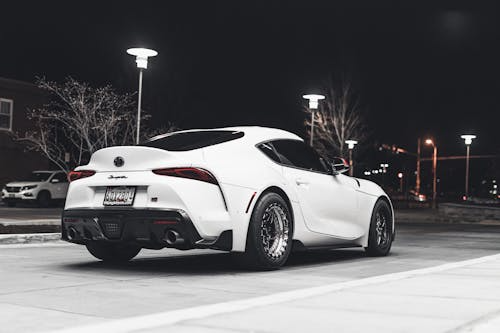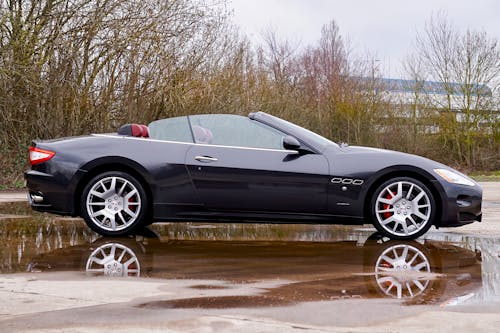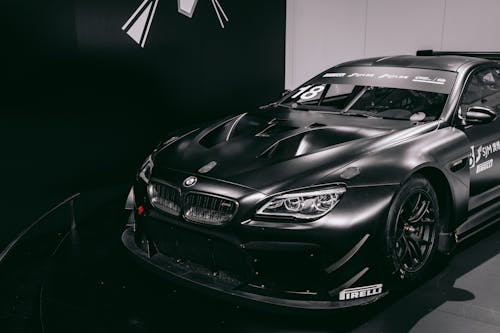A Must-Read for Car Owners: Installation Standards and Legal Requirements for LED Headlights
Bliauto guides car owners on installation standards and legal requirements for LED headlights. Learn about manufacturing LED headlights, brand manufacturers of LED headlights, and choosing brand LED headlights compliant with safety and law.
- 1. What Are LED Headlights?
- 2. Why Choose LED Headlights?
- 1. High Brightness and Low Energy Consumption:
- 2. Long Lifespan:
- 3. Environmental Friendliness:
- 4. Excellent Optical Effects:
- 3. Legal Requirements for Installing LED Headlights
- 1. Automotive Lighting System Regulations
- 2. LED Headlight Certification Requirements
- 3. Legality of Installation
- 4. Things to Consider When Installing LED Headlights
- 1. Choose the Right LED Headlights
- 2. Professional Installation
- 3. Adjust the Light Beam Angle
- 4. Regular Inspection and Maintenance
- 5. Frequently Asked Questions
- 6. Conclusion
With the continuous development of automotive lighting technology, LED headlights have become a popular upgrade choice for many car owners. Compared to traditional halogen bulbs, LED headlights offer significant advantages in terms of brightness, energy efficiency, lifespan, and aesthetics. Their unique design and features have made them a preferred option for many drivers. However, when installing and using LED headlights, car owners must understand the relevant installation standards and legal requirements to ensure safety, compliance, and optimal performance. This article will explore the installation standards and legal requirements for LED headlights, providing car owners with essential knowledge and guidance.
1. What Are LED Headlights?
LED (Light Emitting Diode) headlights are lighting devices that utilize semiconductor materials to emit light when an electric current is applied. Compared to traditional halogen and xenon bulbs, LED headlights have higher brightness, lower energy consumption, and longer lifespans. Additionally, LED headlights are more flexible in design, allowing for various optical effects such as matrix lighting, dynamic turn signals, and more.
2. Why Choose LED Headlights?
1. High Brightness and Low Energy Consumption:
LED headlights are brighter than halogen and xenon lights while consuming less energy. This means car owners can get better illumination with lower energy consumption, which is especially beneficial for night driving or driving in poor visibility conditions.
2. Long Lifespan:
LED headlights typically last over 50,000 hours, much longer than traditional halogen bulbs, which last about 1,000 hours. This extended lifespan reduces the frequency of bulb replacements and lowers maintenance costs.
3. Environmental Friendliness:
LED headlights do not contain harmful substances like mercury, making them more environmentally friendly compared to traditional bulbs. Moreover, their high energy efficiency and low carbon emissions contribute to reducing the overall environmental impact of the vehicle.
4. Excellent Optical Effects:
LED headlights allow for flexible light beam designs, such as matrix lighting, adaptive high beams, and dynamic light bars, which enhance the driving experience and improve vehicle aesthetics.
3. Legal Requirements for Installing LED Headlights
In most countries and regions, there are strict regulations governing automotive lighting systems' installation and modification. Car owners must comply with these legal requirements when installing LED headlights to ensure that their vehicles remain safe and compliant with local laws.
1. Automotive Lighting System Regulations
Brightness Requirements:
LED headlights must comply with the maximum brightness levels specified by national traffic authorities. Overly bright headlights can cause glare, which impairs the vision of other drivers, leading to safety risks. Therefore, the LED headlights installed must meet regulatory standards for light intensity.
High/Low Beam Adjustment:
LED headlights must feature an automatic high/low beam adjustment system to ensure that high beams do not dazzle vehicles in front. Many countries require vehicles to have such systems to reduce the likelihood of traffic accidents.
Light Beam Distribution:
LED headlights should distribute light evenly to ensure that the driver can clearly see the road ahead during nighttime or in low-visibility conditions. Additionally, the light beam should not diverge outside the prescribed range to avoid blinding other road users.

2. LED Headlight Certification Requirements
In many countries and regions, automotive lighting devices must meet specific certification standards. For example, in the European Union and China, lighting systems must be certified with an E-mark certification or CCC certification. These certifications indicate that the lighting products have passed rigorous testing and meet safety standards. When choosing LED headlights, car owners must ensure the products have the necessary certifications to avoid using substandard products.
E-mark Certification: In Europe, the E-mark certification signifies that a product complies with EU regulations. LED headlights that carry this mark are deemed to meet European safety standards.
CCC Certification: In China, the CCC (China Compulsory Certification) mark indicates that a product has passed China’s national standards testing and is legally sold in the market.
3. Legality of Installation
In some countries, modification of automotive lighting systems requires prior approval or permission. Before installing LED headlights, car owners should familiarize themselves with local traffic regulations to ensure that the lights meet legal requirements. For example:
No Overmodification Allowed: In some regions, car owners are not permitted to modify vehicle lighting systems freely and must replace lights according to the original design. Unauthorized modifications may result in fines or failure to pass vehicle inspections.
Professional Installation Required: Certain countries require lighting system modifications to be done by qualified professionals or certified auto repair shops to ensure compliance and avoid negatively impacting the vehicle’s performance.
4. Things to Consider When Installing LED Headlights
Once car owners have ensured that their LED headlights comply with legal requirements, they should pay attention to the following points during installation:
1. Choose the Right LED Headlights
Car owners should consider several factors when selecting LED headlights, including
Compatibility: Not all LED headlights are compatible with every vehicle model. Before installation, car owners should verify that the LED headlights are compatible with their car’s lighting system, especially the bulb base, power, and voltage.
Color Temperature: LED headlights typically have color temperatures ranging from 3,000K to 6,500K. Car owners should select the appropriate color temperature based on personal preferences and local driving conditions. Lower color temperatures (e.g., 3,000K) are suitable for city driving, while higher color temperatures (e.g., 6,000K) are better for highways or rural driving.
Certified Products: Car owners should choose LED headlights that are certified and meet the required safety and quality standards.
2. Professional Installation
Although installing LED headlights may seem straightforward, car owners are advised to have the installation carried out by a professional auto repair shop to ensure safety and compliance. Professionals will ensure that the headlights are correctly aligned to avoid non-compliant light beams that could create safety hazards.
3. Adjust the Light Beam Angle
After installation, it is crucial to adjust the angle of the LED headlights. Misaligned headlights can result in poor visibility and potentially cause glare for other drivers, creating unnecessary safety risks. Many auto repair shops offer light beam alignment services to ensure that LED headlights meet regulatory requirements.
4. Regular Inspection and Maintenance
Although LED headlights have a long lifespan, their brightness may decrease over time, or they may experience malfunctions. Car owners should regularly check the performance of their LED headlights to ensure they are in optimal working condition.

5. Frequently Asked Questions
1. Can I install LED headlights myself?
While LED headlight installation is relatively simple, it is recommended that car owners have them installed by a professional auto repair shop to ensure safety and compliance with legal requirements.
2. Are LED headlights suitable for all vehicle models?
Not all LED headlights are compatible with every vehicle model. Car owners should verify that the LED headlights match their vehicle's lighting system, including the bulb base, power, and voltage specifications.
3. Can I replace my halogen headlights with non-original LED headlights?
It is possible to replace halogen headlights with non-original LED headlights, but it is essential to ensure that the chosen LED headlights comply with local traffic regulations and have the necessary certifications to avoid legal issues and safety hazards.
4. Will installing LED headlights affect my vehicle’s inspection?
If the LED headlights installed do not comply with local regulations or lack proper certification, they may cause the vehicle to fail inspection. Therefore, it is important for car owners to ensure that the LED headlights they install meet inspection requirements.
5. What is the lifespan of LED headlights?
LED headlights generally last up to 50,000 hours, far surpassing the lifespan of halogen and xenon lights. Even after prolonged use, LED headlights maintain a high level of brightness.

6. Conclusion
LED headlights are an efficient, eco-friendly, and high-performance lighting solution that is rapidly becoming the standard in automotive lighting. However, when installing and using LED headlights, car owners must strictly adhere to relevant regulations and installation standards to ensure safety and compliance. By choosing the right LED headlights, ensuring professional installation, and regularly maintaining them, car owners can enhance their nighttime driving safety while enjoying the many benefits of LED headlights.
Learn more about our automotive lighting products.

The most advanced line of high-performance LED headlights available. Model 2046 provides a 4×6 LED headlight with a high and low beam design as the main lighting for the vehicle.

Bliauto Motorcycle Headlight - Model C1H-WA: High-quality LED design from leading brand manufacturers of motorcycle headlights. Precision Manufacturing Motorcycle Headlight ensures high visibility, durability, and easy fit for all riders.

Bliauto Motorcycle Headlight - Model C1H-HL: High-quality brand motorcycle headlight with durable LEDs, easy installation, and high-beam performance. Trusted brand manufacturers motorcycle headlights for safety. Choose Manufacturing Motorcycle Headlight quality.

Bliauto JS1 Jump Starter – Reliable Power On-the-Go As a brand manufacturer & wholesale jump starter supplier, Bliauto delivers high-quality portable power solutions. The JS1 Jump Starter provides instant engine starts, USB charging, and durable performance—ideal for emergencies. Trusted by professionals, it’s compact, safe, and backed by expert engineering. Wholesale options are available—power up with Bliauto! Optimized for SEO with target keywords while maintaining clarity and brand authority. Let me know if you'd like refinements!
Connect with Bliauto for Automotive LED Lights Solution
Bliauto is dedicated to designing innovative automotive LED lighting systems. Let's talk about your needs!
© 2025 Bliauto All Rights Reserved.

Bliauto
Bliauto Light
Bliauto
Bliauto Light
Bliauto
Whatsapp: +8618811846160